The 38th parallel is just a geographical term for most people but for Koreans, it became a dividing line, first drawn by the superpowers and then hardened by the war. South Korea and North Korea have been separate states for almost 80 years, with the same nation but completely different social systems after millennia of shared history. Although the gap between these two worlds widens over the years, the dream of reunification continues to live in the hearts of Koreans.
On the opposite sides of the 38th parallel
After World War II, the victorious superpowers decide to take Korea under their wing, which was colonized by Japan between 1910 and 1945. The United States and the Soviet Union temporarily separated Korea in two using the 38th parallel as a dividing line. Although the Moscow Conference of 1945 decided to establish a 5-year trusteeship by 4 powers - the United States, the Soviet Union, the United Kingdom and China - before achieving Korea’s independence, this idea was not popular among Koreans. Because of the local riots and escalating Cold War, the superpowers never reached an agreement. The implementation of joint elections also failed because neither the Soviet Union nor the United States was willing to lose influence over the peninsula’s northern and southern parts respectively. Thus in 1948 two separate states declared their independence on the Korean Peninsula: the Republic of Korea (South Korea) and the Democratic People's Republic of Korea (North Korea).
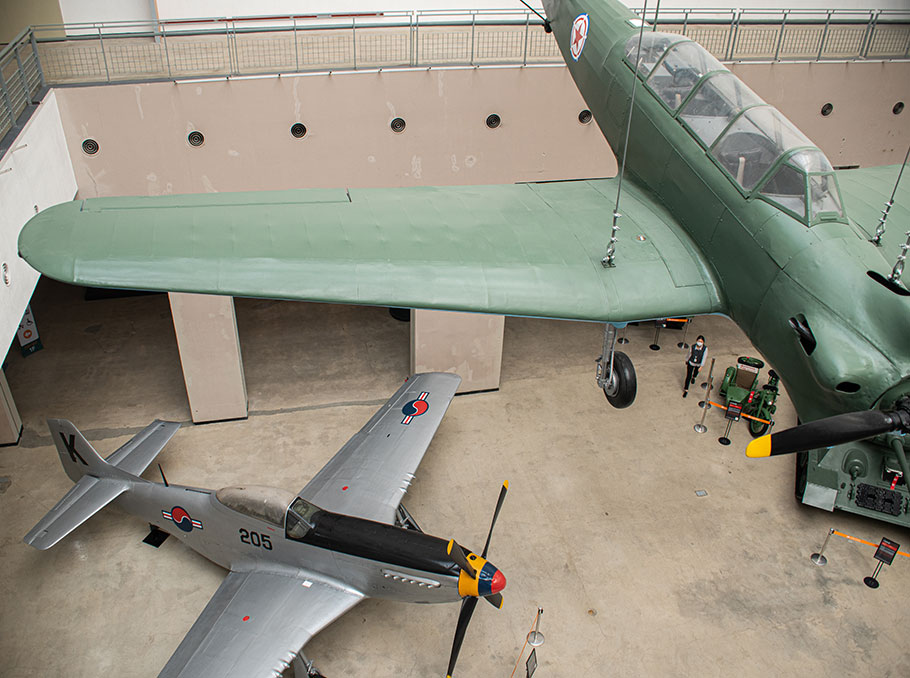 The War Memorial of Korea in Seoul
The War Memorial of Korea in SeoulPhoto: Mediamax
Since 1948, there had been continuous armed clashes along the Korean border as each side sought to establish control over the entire peninsula. In June 1950, the North Korean forces, armed with Soviet weapons, invaded South Korea thus starting the Korean War.
US and UN troops came to support South Korea, successfully pushing back the North Korean army and advancing north of the 38th parallel. To prevent the further spread of capitalism, communist China also intervened in the war and pushed back the combined forces of the United Nations and South Korea to the 38th parallel.
 The War Memorial of Korea in Seoul
The War Memorial of Korea in SeoulPhoto: Mediamax
The Korean War ended with an armistice agreement signed in July 1953 that established a demilitarized zone along the entire border. Till today no peace agreement has been signed between the two countries, and the negotiations have not yielded substantive results. The conflict is frozen, with occasional border tensions, and the same nation remains divided into two different realities.
North Korea from Dorasan Observatory
“End of Separation, Beginning of Unification”: this sentence was on the military building on the way to the demilitarized zone. The road led to Dorasan observatory, from where you can see the territory of North Korea through binoculars.
 Dora/Dorasan observatory
Dora/Dorasan observatoryPhoto: KOCIS
The DMZ is 250 km long and 4 km wide. According to the agreement, each of the sides can have one residential area in DMZ. In the case of South Korea, it is the village Daeseong-dong, and in front of it is North Korea’s it is Kijong-dong village. The latter is named a ‘’Peace village’’ in North Korea, while it is called “Propaganda village” in South Korea.
Kijong-dong got this name for several reasons. First, observations from the South Korean side have shown that the village is fake - the beautiful houses are just a facade. In addition, loudspeakers were installed in the village for a long time, through which propaganda was broadcast. In response, the South Korean side also installed loudspeakers and played K-pop music. This propaganda noise has been stopped ahead of the 2018 meeting of the leaders of the two countries.
 The flags in the villages of Daeseong-dong and Kijong-dong
The flags in the villages of Daeseong-dong and Kijong-dongPhoto: Mediamax
From the observatory, the flags on the high towers erected in these two villages can be seen even without binoculars. South Korea was the first to raise its flag in 1980 with a tower of 99 meters high. Soon North Korea installed a taller tower of 159 meters high, remaining the world leader for many years.
From Dorasan observatory the North Korean city Kaesong could also be seen. It was the capital of Korea in the 10th-14th centuries. In 2004, with mutual agreement and the investment of South Korea, an industrial complex was opened in Kaesong, where Koreans from North and South worked together in the production of South Korean companies.
 View of Kaesong from Dorasan Observatory
View of Kaesong from Dorasan ObservatoryPhoto: Mediamax
However, the complex was shut down in 2016 with the decision of the South Korean government after 12 years of operation, with the aim of pressuring the North Korean government to stop nuclear testing, as the complex's operation was a boost to the North Korean economy.
The attack tunnels as a tourist attraction
Between the 1960s and 1980s, North Korea dug a series of tunnels along the DMZ for a surprise invasion of South Korea. To date, the South Korean side has discovered 4 tunnels, but it is believed that there are more.
In 1974, at one place of the demilitarized zone, South Korean soldiers noticed steam rising from the ground and began to investigate the area. At that time, the opposite side opened fire in their direction, and after the return fire, the search in the area continued. Thus, the first tunnel was revealed. It is 45 meters below the ground, 1.2 meters high, and about one meter wide, with a total length of 3,500 meters.
 The white power tower belongs to South Korea, the black one belongs to North Korea
The white power tower belongs to South Korea, the black one belongs to North KoreaPhoto: Mediamax
A year later, a second tunnel was discovered, which is about 2 times wider than the previous one. In 1978, a North Korean defector reported about the third tunnel, and in 1990, a fourth tunnel was discovered.
According to North Korea, these tunnels are intended for coal mining, but no coal has been found at the site.
 Information panel of the 3rd tunnel
Information panel of the 3rd tunnelPhoto: Mediamax
Apart from the first, all the other tunnels have tourist importance today. Wearing protective helmets tourists are free to go through the tunnels. Of course, after a certain distance, the South Korean side put up concrete barriers to exclude a possible invasion from the other side.
The dream of reunification
Reunification is a dream for many Koreans. One of its beautiful symbols is the statue near the 3rd tunnel, which represents the people striving to unite the two Koreas.
 Reunification monument near the 3rd Tunnel, South Korea
Reunification monument near the 3rd Tunnel, South KoreaPhoto: Mediamax
For 92-year-old Korean War veteran Ryu Seung-seok, seeing Korea united again is also a great dream. He was 17 when joined the South Korean army as a volunteer because of the war.
"There should not be war, it is a tragedy. There is a huge difference in the way of thinking between people who have seen the Korean War and those who have not. After 1945, when Korea was liberated from the Japanese yoke, the Korean War began just 5 years later. During those 5 years, North Korea was preparing for war while South Korea was making efforts to establish peace and democracy. That is why we could not repel the North Korean attack at the beginning of the war. I want to emphasize again that there should not be wars, they do not give any advantage, they only have negative consequences. I have long dreamed of the reunification of the two Koreas, and I hope to see it happen in my lifetime. At the same time, I understand that it is not an easy task. I believe that North Korea is a type of country that is impossible to have a dialogue with, so this issue cannot be solved immediately. To achieve this, we must put aside personal interests and dedicate our lives to the cause of reunification," says the veteran.
 Korean War veteran Ryu Seung-seok
Korean War veteran Ryu Seung-seokPhoto: Mediamax
He believes the best solution for the Korean people would be for North Korea to abandon its nuclear weapons tests. In turn, South Korea should also be able to make concessions and be ready to provide economic support.
The unification is far off
According to diplomat Choi Woo son, a senior professor at the Korea National Diplomatic Academy, South Korea seeks to maintain a balance between the US and China. On the one hand, a military balance must be maintained for peace on the Korean Peninsula, so allied relations with the US are compulsory, and on the other hand, good relations with China are necessary both economically and in terms of improving inter-Korean relations.
"We cannot choose between China and the United States. Korea will strengthen relations with the US, but at the same time, it emphasizes cooperation with China. Nevertheless, both China and the USA are fighting for the leading position in the world, so the tension between them is inevitable," he says.
 Choi Woo son, senior professor at the Korea National Diplomatic Academy
Choi Woo son, senior professor at the Korea National Diplomatic AcademyPhoto: Mediamax
According to the diplomat, at present it is very unlikely to resolve inter-Korean relations through dialogue. That is why South Korea had to choose the path of strengthening alliance relations with the United States, and this was reflected in their defense system development plans.
 The view of South Korea from DMZ
The view of South Korea from DMZPhoto: Mediamax
"I do not think North Korea will give up nuclear weapons tests because it is for the viability of their regime. Negotiations for denuclearization have not yet yielded results, and efforts to improve relations have stalled. Of course, our ultimate goal is reunification, but it is a very difficult path in our times," he says.
The pain and power of memory
"If you want peace, remember war" - this thought is carved on the Peace Square of Seoul’s War Memorial.
On the right and left sides of the complex stretch wide halls, where 204 monuments are placed, each with 1,500 names engraved. Those are the names of Korean war victims both from Korean and UN forces. The halls are deliberately open so that the sunlight, meeting the monuments, creates shadows, thus showing the harmony of light and dark.

Photo: Mediamax
In the courtyard of the memorial, there is a Statue of Brothers symbolizing the Korean War. This was created based on a true story of two brothers meeting on the battlefield while fighting for opposing armies.
It captures the meaning of reconciliation, love, and forgiveness in the image of brothers holding each other as one. At the same time, it symbolizes the nature of the Korean War, a fratricidal tragedy.
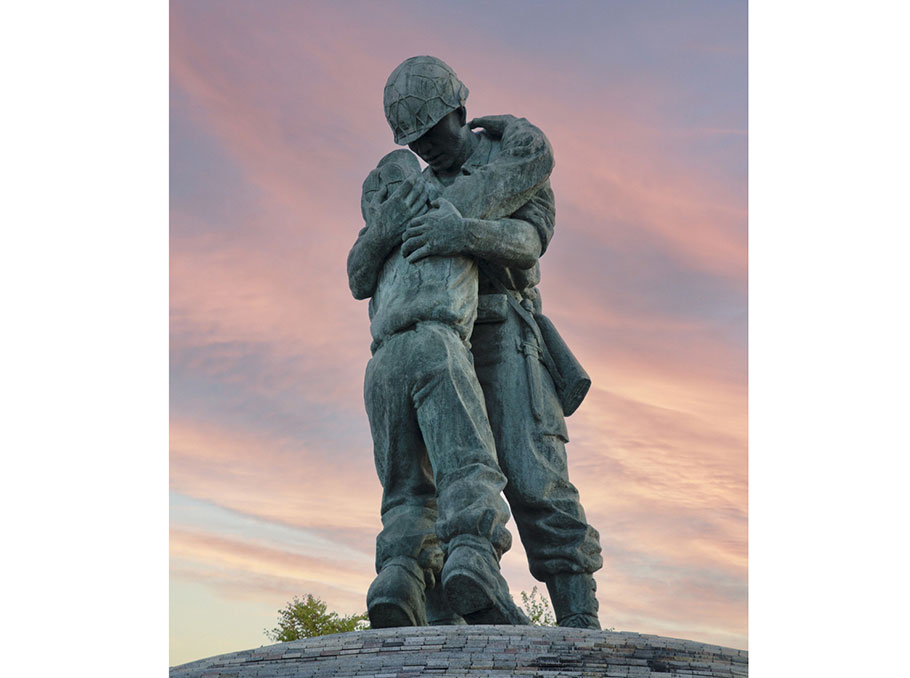 The Statue of Brothers
The Statue of BrothersPhoto: The War Memorial of Korea
At the end of the Memorial Hall, there is a mystical monument named “Creation”. It expresses the moment when water, the source of life, and sunlight, the energy itself, come together on the hemispherical sculpture symbolizing the Korean Peninsula to create new life. What makes the monument even more intriguing is that the light goes down in one dense beam, a combination of natural and artificial lights
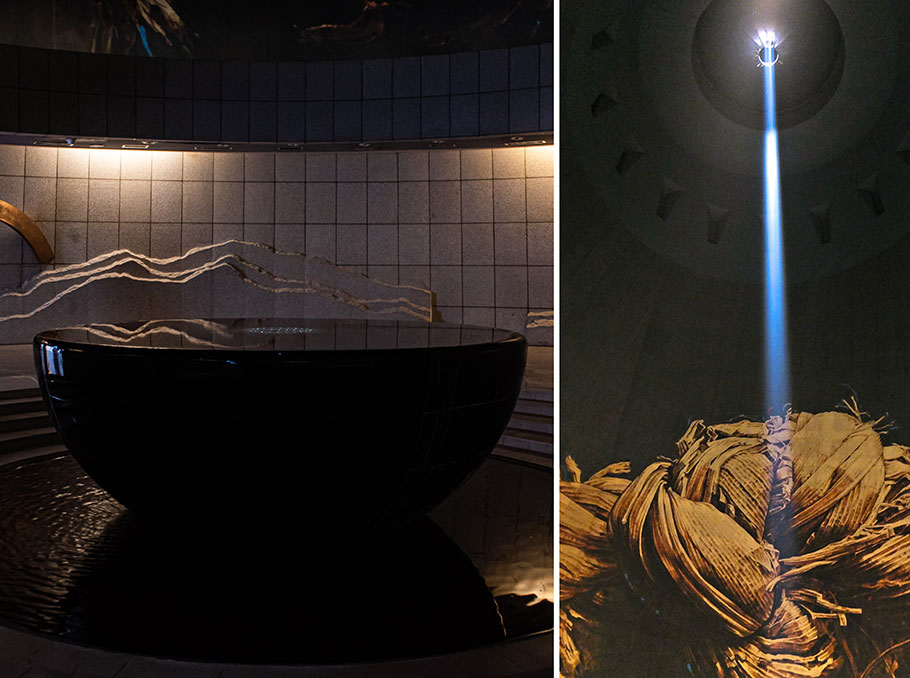 Monument named “Creation”
Monument named “Creation”Photo: Mediamax եւ alonetog3ther.wordpress.com
“The Drop” art installation is also dedicated to the victims of the war, where the drop consisting of more than 1,300 identification tags of soldiers.
As Dog Man Kim, the author of the art installation indicates, the idea came to him while reading a book called "The War letters”. This book is a collection of letters that soldiers sent home from various wars around the world. He was so touched by the letters that wanted to do something to honor these soldiers. He started to gather the names of soldiers and their information through the Korean Military of Defense archives. He used 1300 ID tags putting all the names that he found and also added some blank ones for those soldiers who were missing or forgotten.
 “The Drop” art installation
“The Drop” art installation Photo: Mediamax
While the art installation is playing, we listen to the story of the Korean War and see its scenes through the projector. As the story ends, we feel the drops fall for every life lost, and then the entire floor covers with the ID tags, but also flowers bloom on them.
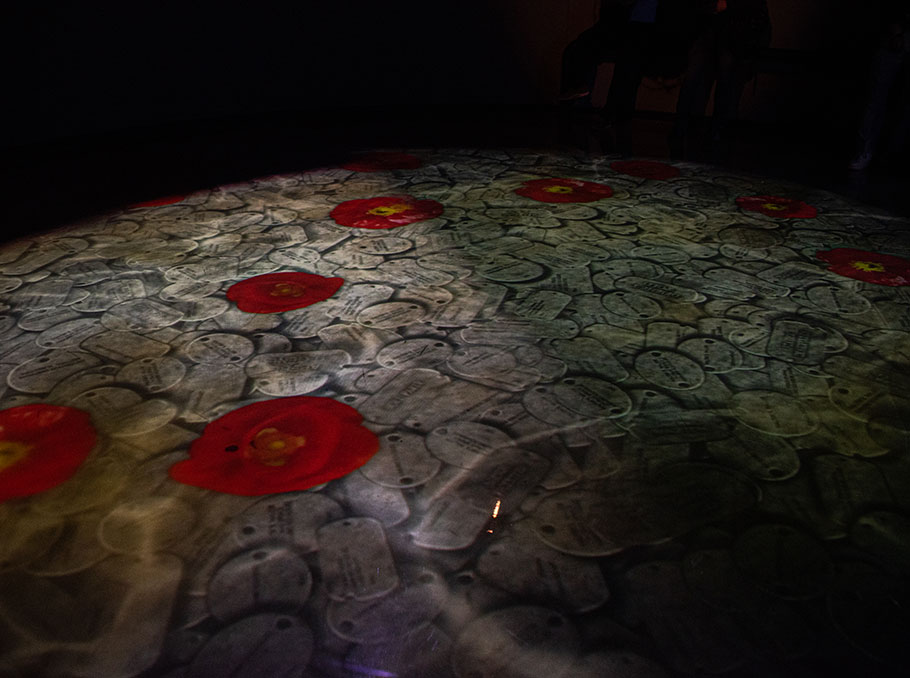
Photo: Mediamax
"We never forget. This is our weakness, but also our strength. We always keep the pain in our hearts and it weakens us, but at the same time, that memory forces us to do uttermost so that what have happened never happens again," the Korean friend of Mediamax’s reporter told her after visiting the memorial.
Gayane Yenokyan (Seoul-Yerevan)
The article was prepared with help of interpreters Park Joon Soo (Korean-Russian ) and Alex Seo (Korean-English) within the framework of 2022 overseas journalist invitation program for “Peace on Korean Peninsula” by Korean Culture and Information Service.
















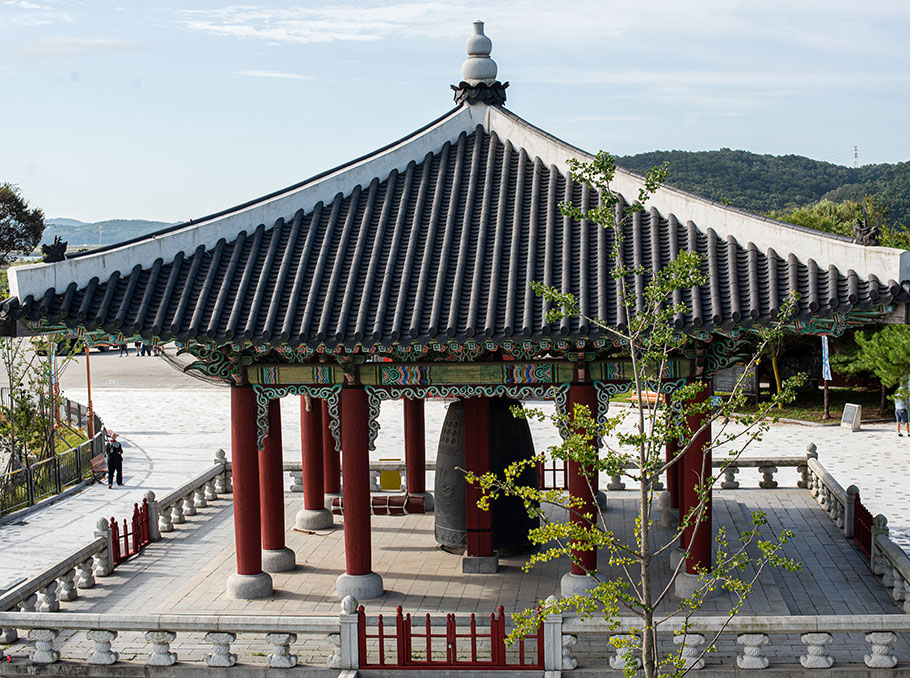









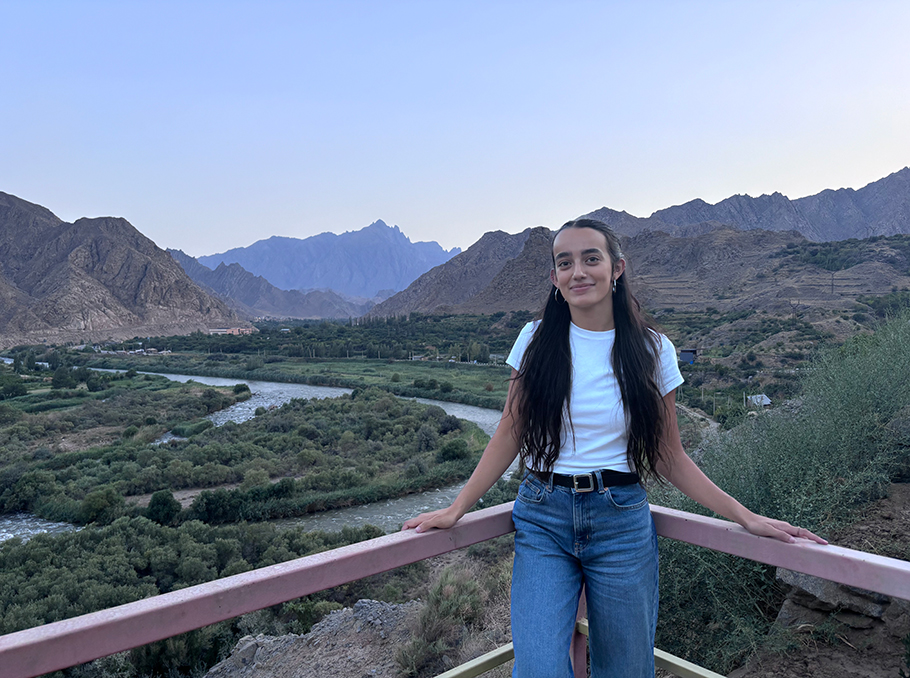









Comments
Dear visitors, You can place your opinion on the material using your Facebook account. Please, be polite and follow our simple rules: you are not allowed to make off - topic comments, place advertisements, use abusive and filthy language. The editorial staff reserves the right to moderate and delete comments in case of breach of the rules.